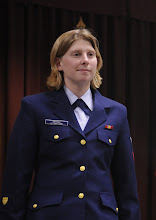The Coast Guard Cutter Polar Sea’s red hull cuts through the icy waters of the Arctic Ocean set on finding polar bears. Aboard the 399-foot icebreaker is a team of scientists dedicated to recapturing bears that are tagged with collars that transmit a global positioning signal to a locater device allowing the cutter’s crew to steam toward the bears. The scientists are hoping to gain a better understanding of how polar bears are surviving in their changing environment.
In the spring scientists, working from a base camp near Deadhorse, Alaska, used helicopters to track polar bear paw prints and locate the animals.
“We targeted females because male bears necks are bigger than their heads and can shake off the collars,” said Dr. Merav Ben David, professor of Zoology at the University of Wyoming and one of the lead scientists in charge of the mission.
Every spring, as temperatures warm and ice melts, the polar bears either stay near shore, and scavenge for food, or follow the receding ice to hunt for seals.
While the earth as a whole is getting warmer, polar bears are losing their hunting ground. Scientists are going to use the data collected from the recaptured bears to analyze how ice loss is affecting these arctic creatures, said Ben David.
Ben David said that the scientists captured and collared 19 bears. Of those bears that were caught and released four shook off their collars and two remained on shore. This leaves 13 bears for scientists to track, tranquilize, study and release.
The collars, in addition to transmitting a position signal, also relay the ambient temperature and are submersible, to study how much time the polar bears spend in the water.
The collars are outfitted with a self-release mechanism, and slated to separate from the bears on Nov. 1. The scientists, working together with the Coast Guard, have limited time to find the bears before the collars deactivate.
The Coast Guard was commissioned by the National Science Foundation to transport the scientists to the northern end of the earth. The Polar Sea’s icebreaking capabilities allows the scientists to get closer than ever to the polar bears and study the bears in a new way. This collaboration marks the first time bears have been studied using the Polar Sea.

























